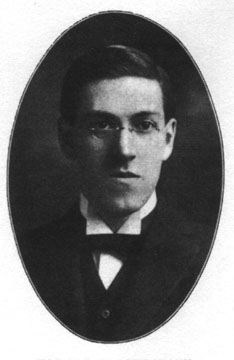| BIO
This article originally appeared
in "The Arkham Advertiser" volume 1, issue 1. Copyright Miskatonic
University Press |
Howard Phillips Lovecraft
***
1890-1937
Howard Phillips Lovecraft was born on August 20,
1890 in Providence, Rhode Island, the son of Winfield Scott Lovecraft and
his wife Sarah Phillips Lovecraft. His father was a traveling salesman
who was struck with paresis (slight or partial paralysis) in 1893 and sent
to a sanatorium where he
eventually died. Lovecraft was raised in the
affluent and intellectual surroundings of his grandfather Whipple Phillips's
Victorian mansion. Following the death of his grandfather in 1904, Lovecraft
and his mother moved from the family mansion to a nearby duplex.
Mrs. Lovecraft was, according to H.P.L. biographer
August Derleth, "determined to shelter her son from the rigors and dangers
of life." Lovecraft admitted that, being raised by a sensitive and overprotective
mother, he grew up in relative isolation, forced to think of himself as
unlike other
people. He was, he claimed, a precocious child
and "very peculiar and sensitive, always preferring the society of grown
persons to that of other children. I could not keep away from printed matter.
I had learned the alphabet at two, and at four could read with ease..."
Chronic sickness in his teenage years prevented
him from finishing high school or attending college (which would have been
Brown University, most likely) but he continued his education at home.
His main interest as a child was the sciences, and his earliest writings
were on scientific subjects. At sixteen he was contributing a monthly article
on astronomy to the Providence Tribune. He was also an avid student of
Colonial history and New England lore and legendry. This backward look
into eighteenth century local history and his interest in twentieth century
science would be foundations for his stories and poetry throughout his
life.
He spent most of his life in Providence where
he lived with his mother and aunts. He supported himself as a ghost writer
and revised other author's stories - jobs that, though he disliked editing
other's work, would financially (though meagerly) sustain him throughout
his life. An admirer of Poe, he began writing horror stories but did not
consider them worthy of publication. In 1914 Lovecraft was invited to join
the United Amateur Press Association, a group of nonprofessional writers
who produced a variety of publications and exchanged letters. A year later
he began publishing his own magazine, The Conservative. His numerous letters
and essays written during this time focus on his deep respect for scientific
truth, his love of the past, and his relative disdain for the present-day
world. Lovecraft developed the belief, divulged Darrell Schweitzer in The
Dream Quest of H. P. Lovecraft, "that only by clinging to tradition could
we make life worth living amidst the chaos of modern civilization." His
first published story, "The Alchemist" (written in 1908 when he was 18),
appeared in the United Amateur (a publication of the United Amateur Press
Association) in 1916 (when
he was 26).
At the urging of his friends, Lovecraft returned
to writing fiction in 1917 and began submitting stories again. His work
began to appear in little magazines like the Vagrant and Home Brew. It
was not until his story "Dagon" was published in the October, 1923 issue
of the magazine Weird Tales that Lovecraft began to have a regular market
for his stories.
In 1924, Lovecraft married Mrs. Sonia Greene,
a writer living in New York City. He lived with his wife in Brooklyn for
a little less than two years before they were divorced in 1929. As soon
as they separated, Lovecraft returned to Providence which he left thereafter
only to make several short winter trips south.
A shy, withdrawn, imaginative, and physically
delicate person, convinced he was ugly and, therefore, socially ill-at-ease,
Lovecraft preferred to live in his imagination rather than in reality.
He lived a solitary life but kept up a voluminous correspondence. He liked
to write at night. Even during the day, he would draw the shades and work
by electric light.
Recognition was slow in coming, but by the late
1920's his work was being reprinted in anthologies of horror stories, and
two of the stories had honorable mention in the O'Brien collections. By
far the greatest number of his stories was published in Weird Tales; others
appeared in Amazing Stories, Astounding Stories, and Tales of Magic and
Mystery. Lovecraft also produced a relatively large body of poetry, mostly
imitations of eighteenth century masters. Though he wrote prolifically,
only one book, 1936's The Shadow Over Innsmouth, was published during his
lifetime.
The many volumes of Lovecraft's letters, collected
in a series of volumes by Arkham House, attest to his brilliance as a correspondent.
Lovecraft was never satisfied with his own writing, feeling that "it was
touched with commercialism and fell too far short of what he intended it
to be." "No one is more acutely conscious than I of the inadequacy of my
work... I am a self-confessed amateur and bungler, and have not much hope
of improvement," the author confessed in "The Defense Reopens!," an article
later collected in S.T. Joshi's In Defense of Dagon. He did, however, consider
himself a serious artist, a literary practitioner and theorist. Lovecraft
"demanded that the fantastic tale be treated as art, not just a frivolous
parlor game or an easy way to make a buck," wrote Schweitzer. Placing himself
among those whom he considered "imaginative artists," such as Poe, Lord
Dunsany, William Blake, and Ambrose Bierce, Lovecraft explained in "The
Defense Reopens!": "The imaginative writer devotes himself to art in its
most essential sense... He is the painter of moods and mind-pictures -
a capturer and amplifier of elusive dreams and fancies - a voyager into
those unheard-of lands which are glimpsed through the veil of actuality
but rarely, and only by the most sensitive... Most persons do not understand
what he says, and most of those who do understand object because his statements
and pictures are not always pleasant and sometimes quite impossible. But
he exists not for praise, nor thinks of his readers. His only [desire is]
to paint the scenes that pass before his eyes."
Always in poor health, H.P.L. became seriously
ill in 1936 and died in 1937 of intestinal cancer and Bright's disease
(chronic nephritis: inflammation of the kidneys).
tr |
| ... |
Biographical/Critical Sources
Burleson, Donald, H. P. Lovecraft: A Critical
Study, Greenwood Press, 1983
Carter, Lin, Lovecraft: A Look Behind the
"Cthulhu Mythos," Ballantine, 1972
Davis, Sonia H., The Private Life of H. P.
Lovecraft, Necronomicon, 1985
de Camp, L. Sprague, Lovecraft: A Biography,
Doubleday, 1975
Derleth, August, H. P. Lovecraft: A Memoir,
Ben Abramson, 1945
Drane, Janice E., Comtemporary Authors, Gale,
Volume 133, 1991
Faig, Kenneth W.,Jr. H. P. Lovecraft: His
Life, His Work, Necronomicon, 1979
Hay, George, editor, The Necronomicon, Neville
Spearman, 1978
Joshi, S. T., editor, H. P. Lovecraft: Four
Decades of Criticism, Ohio University Press, 1980
Joshi, S. T., In Defense of Dagon, Necronomicon,
1985
Levy, Maurice, Lovecraft: A Study in the Fantastic,
translated by Joshi, Wayne State University, 1988
Long, Frank Belknap, Howard Phillips Lovecraft:
Dreamer on the Nightside, Arkham, 1975
Lovecraft, H. P., Supernatural Horror in Literature,
introduction by August Derleth, Ben Abramson, 1945
Schweitzer, Darrell, The Dream Quest of H.
P. Lovecraft, Borgo Press, 1978 |



